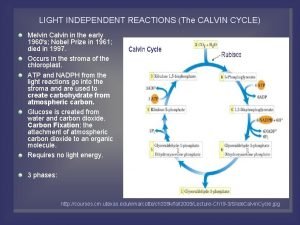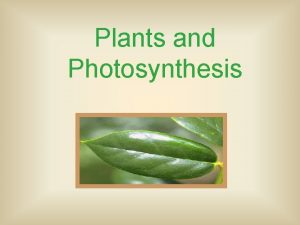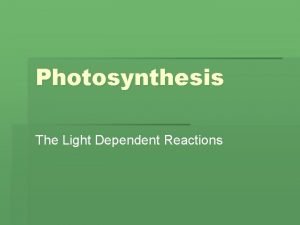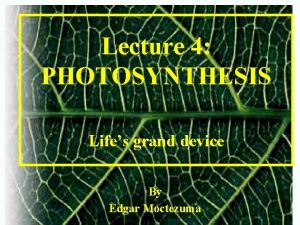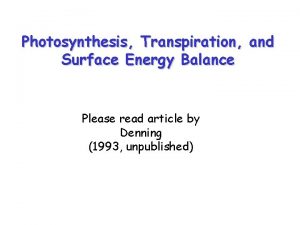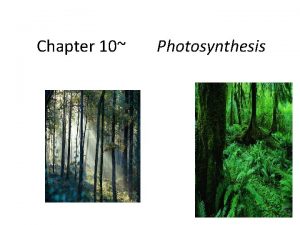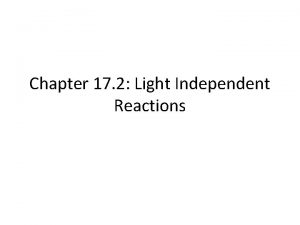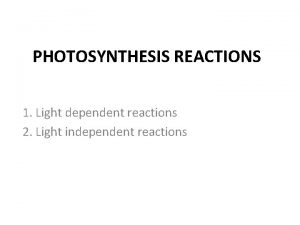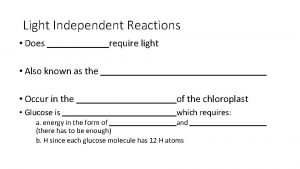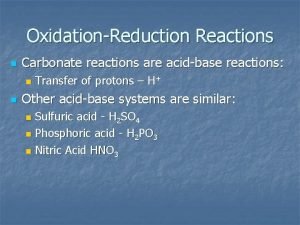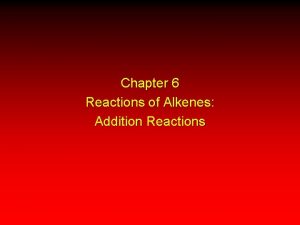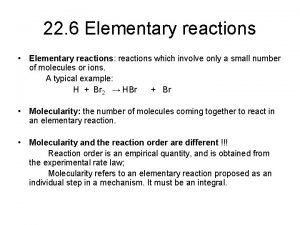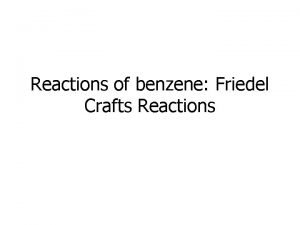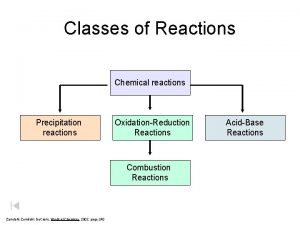The Light Independent Reactions The Light Independent reactions














- Slides: 14

The Light Independent Reactions • The Light Independent reactions take place in sunlight. • If ATP and NADPH are provided, they can be carried out without light (dark reactions). • Like the light-dependent reactions they occur in the chloroplast but in the area surrounding the thylakoid membranes called the stroma.

The Light Independent Reactions • The light independent reactions are also called the Calvin Cycle. • This is because the reactions form a cycle and were discovered by Melvin Calvin. • The Calvin cycle reactions use carbon dioxide (CO 2) along with ATP and NADPH, which were formed by the light reactions, to produce PGAL.

The Light Independent Reactions • PGAL (phosphoglyceraldehyde) is a molecule that is used to make glucose and other organic compounds (e. g. , amino acids & lipids). • Glucose is made because it is more stable and can store more energy than either NADPH or ATP. • To summarize, the light independent reactions provide the raw materials that are used to make most of what the cell needs to survive.

Light Reactions light ATP + NADPH + O 2 energy H 2 O + H 2 O sunlight Energy Building Reactions NADPH ATP AP Biology O 2 § produces ATP § produces NADPH § releases O 2 as a waste product

Calvin Cycle CO 2 + ATP + NADPH C 6 H 12 O 6 + ADP + NADP CO 2 ADP NADP Sugar Building Reactions NADPH ATP AP Biology sugars § builds sugars § uses CO 2, ATP & NADPH § recycles ADP & NADP § back to the lightdependent reactions to make more ATP & NADPH

Photosynthesis

The Light Independent Reactions

The Light Independent Reactions

What factors affect photosynthesis? • 1. Temperature: Photosynthetic enzymes function best between 0°C (32°F) and 35°C (95°F). • 2. Light: High light intensity increases the rate of photosynthesis, up to a certain level. • 3. Water: A shortage of water can slow or even stop photosynthesis.

GLYCOLYSIS AND RESPIRATION glucose (sugar) + oxygen C 6 H 12 O 6 + 6 O 2 carbon dioxide + water 6 CO 2 + 6 H 2 O • Energy stored in chemical bonds of glucose can be used when the bonds are broken. • Cells capture the energy of glucose through the processes of glycolysis and respiration.

GLYCOLYSIS • Glycolysis, which means glucose breaking, is the first phase in the break down of glucose. • It is an anaerobic phase because it takes place without oxygen. • It takes place in the cytoplasm of the cell. • It requires two molecules of ATP to start the process.

GLYCOLYSIS • During the process, the 6 -carbon glucose is split into two 3 - carbon PGAL molecules. • The two PGAL molecules are then transformed into two molecules of pyruvic acid. • During the process, 4 molecules of ATP are produced, resulting in a net gain of 2 ATP. • Also, 2 NADH molecules are produced. • NADH is an energy-storing compound.

GLYCOLYSIS Summary: • In glycolysis, glucose is changed by enzymes into different molecules one step at a time through a series of chemical reactions. • The initial glucose molecule is broken down and transformed into the final product, which is two molecules of pyruvic acid.

GLYCOLYSIS
 Light independent reactions
Light independent reactions Membrane bound organelles
Membrane bound organelles Section 2 reinforcement classifying chemical reactions
Section 2 reinforcement classifying chemical reactions Types of reactions
Types of reactions Section 2 classifying chemical reactions worksheet answers
Section 2 classifying chemical reactions worksheet answers Unit 5 chemical reactions answers
Unit 5 chemical reactions answers Reduction half reaction
Reduction half reaction Light light light chapter 22
Light light light chapter 22 Light light light chapter 22
Light light light chapter 22 Light light light chapter 23
Light light light chapter 23 Autotrophs self-feeder
Autotrophs self-feeder Light dependent formula
Light dependent formula Cellular respiration equation
Cellular respiration equation Structure of chlorophyll
Structure of chlorophyll Light reactions vs calvin cycle
Light reactions vs calvin cycle
